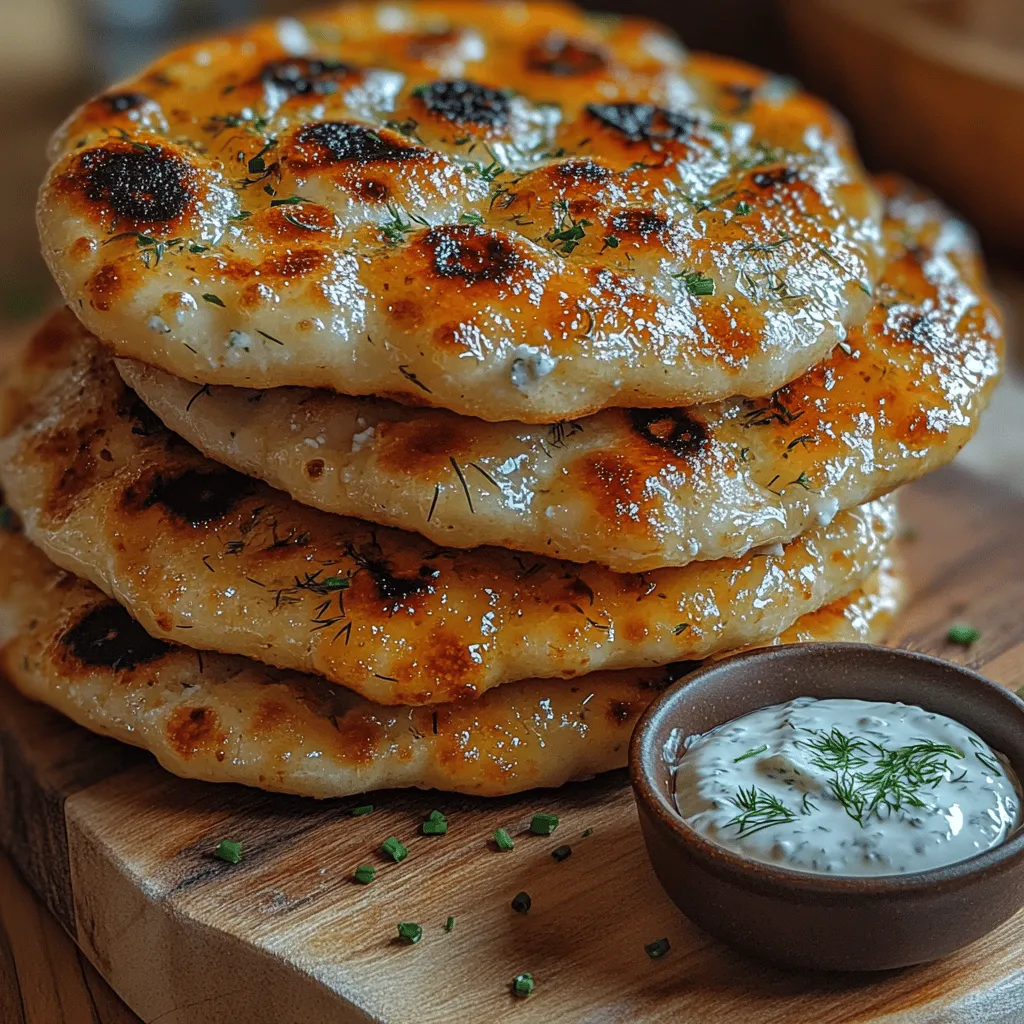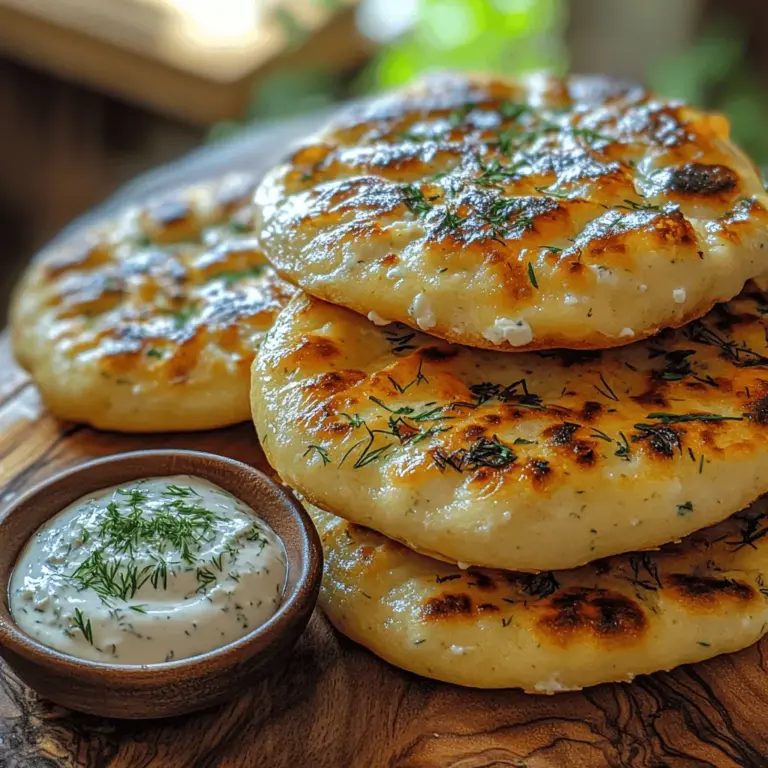Introduction
Flatbreads are an ancient staple enjoyed in various forms across the globe, from the crispy naan of India to the soft pita of the Middle East. Their versatility is unmatched, serving as a base for countless toppings, a side dish to complement meals, or simply as a snack on their own. The beauty of flatbreads lies in their adaptability to different flavors and ingredients, making them a beloved choice in many kitchens.
One such delightful ingredient that elevates flatbreads to new heights is cottage cheese. This creamy, versatile dairy product not only adds a unique flavor profile but also packs a nutritional punch. Cottage cheese is often overlooked in cooking, yet it can transform your flatbread experience, providing both texture and essential nutrients. In this article, we will guide you through a simple yet delicious recipe for Cottage Cheese Delight Flatbread, showcasing how easy it is to incorporate cottage cheese into your meals while enjoying a wholesome and satisfying dish.
Understanding Flatbreads
Definition and History of Flatbreads Across Different Cultures
Flatbreads can be defined as any bread that is made with flour and water and thoroughly rolled into flattened dough. They have been a part of human diet for thousands of years, with evidence of flatbread production dating back to ancient civilizations in the Middle East, where grains were first cultivated. Every culture has its own version of flatbread, each with distinct techniques and ingredients, making it a fascinating topic of culinary exploration.
In Mexico, for example, tortillas serve as a foundational element in countless dishes, from tacos to enchiladas. In Italy, focaccia is a popular flatbread that is often infused with olive oil and herbs, creating a flavorful accompaniment to meals. Meanwhile, in the Mediterranean, pita bread serves not only as a side but also as a pocket for dips like hummus and tzatziki. These examples illustrate the diverse applications of flatbreads, making them an integral part of global cuisine.
The Role of Flatbreads in Meals
Flatbreads can serve multiple roles in a meal. They can be a delightful side dish, providing a perfect accompaniment to soups and stews, or they may act as a base for toppings, turning simple ingredients into a culinary masterpiece. For instance, you might enjoy a flatbread topped with roasted vegetables, cheese, and fresh herbs for a unique and flavorful meal. Additionally, flatbreads can make excellent snacks, whether they are served with dips or enjoyed on their own. Their versatility allows for endless creativity in the kitchen, making them a favorite choice among home cooks.
Overview of Variations in Flatbreads Globally
The world of flatbreads is rich and varied, with each culture contributing its unique twist. In India, the soft and fluffy naan is often served with curries, while the unleavened chapati is a staple in many households. The Middle Eastern lavash is renowned for its thin, flexible texture, ideal for wraps, whereas the thicker, heartier focaccia from Italy is often infused with aromatic herbs and spices. Each type of flatbread brings its own flavor and texture to the table, showcasing the diverse culinary traditions that exist globally.
While store-bought flatbreads are convenient, homemade versions allow for a personal touch and can be customized to suit individual tastes. Making flatbread from scratch can be a rewarding experience, allowing you to experiment with different ingredients and flavors, and ensuring that your dish is fresh and healthy.
The Nutritional Benefits of Cottage Cheese
Cottage cheese is a fantastic ingredient to incorporate into your cooking, especially in recipes like flatbread. It is low in fat and high in protein, making it an excellent choice for those looking to maintain a balanced diet. With about 25 grams of protein per cup, cottage cheese is a powerhouse for muscle repair and growth, making it a favorite among athletes and fitness enthusiasts.
In addition to its protein content, cottage cheese is rich in essential vitamins and minerals. It contains calcium, which is vital for maintaining strong bones and teeth, as well as B vitamins that support metabolism and energy production. Furthermore, cottage cheese is a great source of selenium, an important antioxidant that helps protect the body from oxidative stress.
Despite its numerous health benefits, cottage cheese often gets a bad rap due to its texture and flavor. Some people find it unappealing, thinking it can only be enjoyed in savory dishes or as a standalone snack. However, cottage cheese is incredibly versatile and can be easily incorporated into various meals, from breakfast bowls to baked goods, enhancing flavor and nutrition without overwhelming other ingredients.
Ingredients Breakdown for Cottage Cheese Delight Flatbread
To create your Cottage Cheese Delight Flatbread, you will need the following ingredients:
Cottage Cheese
As the star of the recipe, cottage cheese adds a creamy texture and a mild, slightly tangy flavor to the flatbread. The moisture from the cottage cheese helps keep the flatbread soft and tender, making it an ideal base for toppings or a delicious snack on its own. When selecting cottage cheese, opt for low-fat or full-fat varieties based on your dietary preferences.
All-Purpose Flour
All-purpose flour is the backbone of this recipe, providing structure and consistency to the flatbread. It helps bind the ingredients together and gives the flatbread its characteristic chewy texture. If you’re looking for a healthier option, feel free to substitute part or all of the all-purpose flour with whole wheat flour for added fiber and nutrients.
Baking Powder and Salt
Baking powder serves as the leavening agent in this recipe, giving the flatbread a slight rise and airy texture. It helps create a light and fluffy result while balancing the flavors of the other ingredients. Salt is added not only to enhance flavor but also to improve the overall taste and make the flatbread more enjoyable.
Olive Oil
Olive oil contributes richness and moisture to the flatbread. It adds a subtle fruity flavor while helping to keep the dough pliable and easy to work with. Additionally, olive oil is a source of healthy fats, making this flatbread not only delicious but also a nutritious option for your meals.
With these ingredients, you are well on your way to creating a flavorful and wholesome Cottage Cheese Delight Flatbread that can be enjoyed in various ways. In the next section, we will delve into the step-by-step instructions to guide you through the preparation and cooking process, ensuring that you achieve the perfect flatbread every time. Stay tuned to learn how to bring this delightful recipe to life!

Garlic Powder and Fresh Herbs: Optional Flavor Enhancers
To elevate your Cottage Cheese Delight Flatbread to the next level, consider incorporating garlic powder and fresh herbs into your dough. Garlic powder adds a subtle, savory depth, while fresh herbs such as parsley, dill, or chives introduce a vibrant freshness. These additions not only enhance the flavor but also offer an aromatic experience that can transform your flatbread from simple to spectacular. Feel free to experiment with the amount of garlic powder based on your preference—start with a teaspoon and adjust as needed. Similarly, finely chop fresh herbs and mix them into the dry ingredients for an aromatic touch.
Water: Adjusting Dough Consistency
The amount of water you add to the dough can significantly affect the texture of your flatbread. Start with the recommended amount in the recipe, but remember that different brands of cottage cheese may have varying moisture content. If your dough feels too dry, gradually add more water, one tablespoon at a time, until it reaches a soft, pliable consistency. Conversely, if it’s too sticky, sprinkle in a little extra flour until you achieve the desired texture. The goal is to create a dough that is soft and workable but not overly sticky—this will help you create perfectly shaped flatbreads.
Butter or Ghee: Cooking Medium and Added Flavor
For cooking your Cottage Cheese Delight Flatbread, using butter or ghee is recommended as they add a rich flavor and contribute to a beautiful golden-brown crust. If you’re looking for a healthier option, you can use olive oil or coconut oil. When heating your pan, allow the butter or ghee to melt completely before adding your flatbread. This not only prevents sticking but also ensures that each bite is infused with buttery goodness. If you want to add more flavor, consider brushing the flatbread with melted garlic butter after cooking for an irresistible finish.
Step-by-Step Recipe Instructions
Mixing Dry Ingredients: Importance of Thorough Blending
Start by gathering all your dry ingredients: flour, baking powder, salt, and optional garlic powder. In a large mixing bowl, combine these ingredients thoroughly. A whisk works well for blending dry ingredients, ensuring that the baking powder and salt are evenly distributed throughout the flour. This step is crucial as it helps to create a uniform rise in your flatbreads, resulting in a light and fluffy texture.
Combining Wet Ingredients: Tips for Achieving a Smooth Consistency
In a separate bowl, combine the cottage cheese, eggs, and any fresh herbs you’ve chosen. Use a fork or a hand mixer to blend these ingredients until smooth. The cottage cheese should be well-integrated, with no lumps remaining; this will ensure a consistent texture in your flatbread. If you opt for a creamier flatbread, consider using ricotta cheese as a substitute, further enhancing the richness of the dough.
Forming and Kneading the Dough: Techniques for Optimal Texture
Once your wet ingredients are mixed, create a well in the center of your dry ingredients and pour in the wet mixture. Using a spatula, gently fold the dry ingredients into the wet until they begin to combine. Once the dough starts to come together, transfer it to a lightly floured surface for kneading. Knead the dough for about 5-7 minutes until it becomes smooth and elastic. This step is vital as it develops the gluten, giving the flatbread its chewy texture. Remember to add flour as needed if the dough sticks to your hands or the surface.
Resting the Dough: Benefits of Allowing the Dough to Relax
After kneading, shape the dough into a ball and cover it with a clean kitchen towel or plastic wrap. Allow the dough to rest for at least 15-30 minutes. This resting period is essential as it relaxes the gluten, making the dough easier to roll out and helping to achieve a better texture in the final product. During this time, you can prepare your cooking surface, preheat your skillet, or gather any toppings you plan to use.
Shaping the Flatbreads: Techniques for Uniformity
Once the dough has rested, divide it into equal portions—about 6-8 pieces, depending on your desired size. On a lightly floured surface, take one piece of dough and flatten it with your hands. Using a rolling pin, roll it out to your desired thickness, typically about 1/4 inch thick. Try to maintain a consistent thickness across all flatbreads to ensure even cooking. If you prefer a rustic look, you can also shape them by hand, simply flattening the dough into rounds.
Cooking Process: Tips for Achieving the Perfect Golden-Brown Crust
Heat a non-stick skillet or griddle over medium heat and add a small amount of butter or ghee. Once melted and hot, place your rolled-out flatbread into the skillet. Cook for about 2-3 minutes on each side or until golden brown spots appear. Press down gently with a spatula to ensure even cooking. If necessary, adjust the heat to prevent burning while allowing the bread to cook through. For an extra touch, consider brushing the flatbreads with melted garlic butter after cooking for an enhanced flavor profile.
Serving Suggestions and Pairing Options
Cottage Cheese Delight Flatbread is incredibly versatile and can be served in numerous ways. Here are some delightful serving suggestions:
– Toppings: Spread a layer of hummus, tzatziki, or cream cheese on top for a rich, flavorful experience. Fresh vegetables, olives, or sun-dried tomatoes can add a crunchy texture and vibrant flavor.
– Wraps and Sandwiches: Use the flatbreads as wraps for grilled chicken, roasted vegetables, or falafel. You can also layer them with fresh greens and your favorite protein for a satisfying sandwich.
– Accompanying Dishes: Serve alongside soups, salads, or stews for a wholesome meal. The flatbread’s texture complements hearty dishes beautifully, soaking up flavors and adding a filling element to the meal.
Creative Ways to Enjoy Cottage Cheese Delight Flatbread
The possibilities for enjoying your Cottage Cheese Delight Flatbread are endless. Here are a few creative ideas to inspire you:
– Breakfast Flatbreads: Top your flatbread with scrambled eggs, avocado, and salsa for a delicious breakfast option. The combination of cottage cheese and eggs provides a protein-packed start to your day.
– Flatbread Pizzas: Use the flatbread as a base for mini pizzas. Add tomato sauce, cheese, and your favorite toppings, then bake until the cheese is bubbly and golden.
– Snack Option: Cut the flatbreads into strips and serve them with dips like guacamole or tzatziki for a healthy snack. You can also toast them for a crispy texture.
– Dietary Versatility: This flatbread can easily accommodate different dietary preferences. Use gluten-free flour for a gluten-free version or replace the cottage cheese with a vegan alternative to cater to plant-based diets.
Conclusion
Making Cottage Cheese Delight Flatbread is not only easy but also incredibly rewarding. This recipe brings together simple ingredients to create an utterly delicious and versatile flatbread that can be enjoyed in countless ways. The nutritional benefits of cottage cheese, combined with the wholesome goodness of homemade bread, make this recipe a fantastic addition to any meal.
Whether you enjoy it as a snack, part of a hearty meal, or a healthy breakfast, Cottage Cheese Delight Flatbread offers endless possibilities for creativity in the kitchen. So gather your ingredients, experiment with flavors, and savor the delightful experience of homemade flatbread. Your taste buds will thank you, and you’ll find yourself returning to this recipe time and again for its simplicity and deliciousness. Enjoy the wholesome goodness of homemade cooking and let your culinary imagination run wild!

